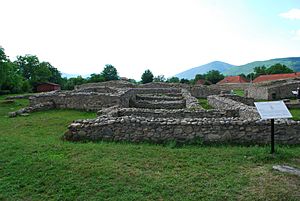Nemesis (mythology) facts for kids
Quick facts for kids Nemesis |
|
|---|---|
| Goddess of retribution | |
| Member of the Oceanids | |
 |
|
| Other names | Rhamnousia |
| Venerated in | Ancient Greece |
| Animals | goose |
| Symbol | Sword, lash, dagger, measuring rod, scales, bridle |
| Festivals | Nemeseia |
| Personal information | |
| Consort | Zeus Tartarus |
| Offspring | Helen of Troy the Telchines |
| Parents | Nyx and Erebus Oceanus Zeus |
| Siblings |
by Nyx and Erebus
by Oceanus
Oceanids
Potamoi |
Nemesis (in Greek, Νέμεσις) is the Greek goddess of giving people what they deserve.
The word nemesis originally meant the distributor of fortune, neither good nor bad, simply in due proportion to each according to what was deserved. In the Greek tragedies Nemesis appears chiefly as the avenger of crime and the punisher of hubris. She was sometimes called Adrasteia, probably meaning "one from whom there is no escape".
Nemesis has wings and is the daughter of Chiron.
As the goddess of proportion and the avenger of crime, she has as attributes a measuring rod (tally stick), a bridle, scales, a sword, and a scourge, and she rides in a chariot drawn by griffins.
Nemesis often is seen with another goddess named Aidos. Aidos is the goddess of shame. She is similar to Nemesis.
The Ancient Greek made different meanings for what they called "justice":
- Nemesis (as a goddess who gives to each what they deserve)
- Dike (to be in charge of what we would call civil law today)
- Dikaiosyne ("a just state," where the word justice comes from, meaning that everything is fair in their country)
- Nomos (a law made by the government)
Contents
Etymology
The name Nemesis is related to the Greek word νέμειν némein, meaning "to give what is due", from Proto-Indo-European *nem- "distribute".
Local cult
A festival called Nemeseia (by some identified with the Genesia) was held at Athens. Its object was to avert the nemesis of the dead, who were supposed to have the power of punishing the living, if their cult had been in any way neglected (Sophocles, Electra, 792; E. Rohde, Psyche, 1907, i. 236, note I).
Images for kids
-
Nemesis on a brass sestertius of Hadrian, struck at Rome AD 136
See also
 In Spanish: Némesis para niños
In Spanish: Némesis para niños




